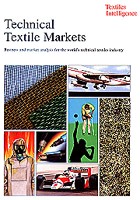
Carrington wins best innovation at Professional Clothing Awards
Personal protective clothing offers a practical solution to eliminating, or at least minimising, the risk of accidents, injuries or infection in the workplace. More specifically, it provides an effective safeguard against hazards such as extreme temperatures, fire, potentially dangerous objects and harmful substances. The main categories of protective clothing include chemical and hazardous material (hazmat) clothing, clean room clothing, combat uniforms, cut resistant workwear,

30th June 2010
Innovation in Textiles
|
 Report Summary
Report SummaryPersonal protective clothing offers a practical solution to eliminating, or at least minimising, the risk of accidents, injuries or infection in the workplace. More specifically, it provides an effective safeguard against hazards such as extreme temperatures, fire, potentially dangerous objects and harmful substances.
The main categories of protective clothing include chemical and hazardous material (hazmat) clothing, clean room clothing, combat uniforms, cut resistant workwear, flame resistant workwear, high visibility apparel, medical protective clothing and multi-functional protective wear.
Fibre types employed include aramids, cotton, modacrylic, polyamide, polybenzimidazole (PBI), polypropylene, ultra high molecular weight polyethylene (UHMWPE) and Vectran. Leading brands of fibres and fabrics used in protective clothing include Cordura Baselayer fabric, Gore Chempak Selectively Permeable Fabric, Defender M, Kermel, Kevlar, Nomex, ProShield, Protera, Sungrazer, Tychem and Tyvek.
Growing concerns about worker safety on the one hand and increasing instances of terror attacks and epidemics on the other have raised awareness about the need for personal protection. This awareness, coupled with rising costs associated with workplace injuries, has resulted in a growing emphasis on compliance with health and safety regulations and performance standards for protective apparel and accessories.
Technological advances in the personal protective equipment (PPE) industry have led to the development of products which not only meet these stringent performance standards but also offer advances in comfort and style. Such advances have helped to increase the proportion of end users who comply with health and safety regulations.
Looking ahead, one of the main challenges is that of cheap imports from Asia—many of which do not comply with rigid specifications in the West. These are proving to be a menace for suppliers of high performance PPE and are limiting market revenues for the industry as a whole.
Nonetheless, rising demand for high performance products which are user-friendly will help to drive growth in the market, and those companies which are able to satisfy the need for increasingly sophisticated PPE should thrive as a result. PPE is a necessity rather than an option in many services and industries, notably those in which worker safety is at risk. The market should therefore enjoy a viable future as legislation becomes more stringent in developed countries, and as industrialisation progresses and legislation is introduced in developing countries.
Personal Protective Clothing: Ensuring Worker Safety
Summary
Introduction
The Market for Personal Protective Equipment
Hazards in the Working Environment and Their Effects
Main Categories of Protective Clothing
Fibres Used in Protective Clothing
Brands of High Performance Fibres and Fabrics Used in Protective Clothing
Standards
Legislation
Outlook
Textiles Intelligence, Technical Textile Markets
29 pages, published 2nd quarter 2010

Business intelligence for the fibre, textiles and apparel industries: technologies, innovations, markets, investments, trade policy, sourcing, strategy...
Find out more